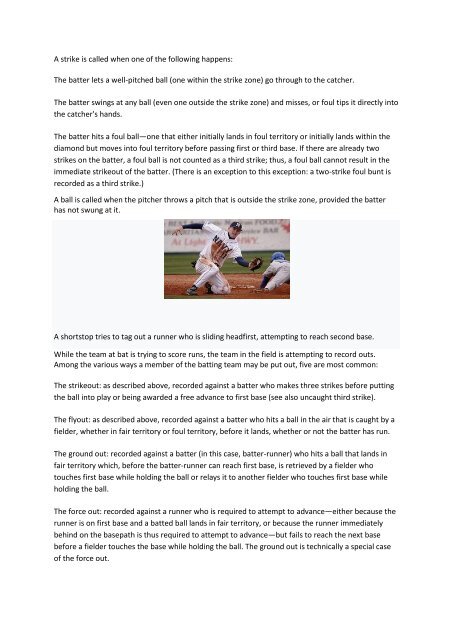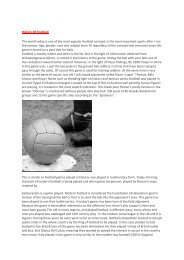Dergi
Create successful ePaper yourself
Turn your PDF publications into a flip-book with our unique Google optimized e-Paper software.
A strike is called when one of the following happens:<br />
The batter lets a well-pitched ball (one within the strike zone) go through to the catcher.<br />
The batter swings at any ball (even one outside the strike zone) and misses, or foul tips it directly into<br />
the catcher's hands.<br />
The batter hits a foul ball—one that either initially lands in foul territory or initially lands within the<br />
diamond but moves into foul territory before passing first or third base. If there are already two<br />
strikes on the batter, a foul ball is not counted as a third strike; thus, a foul ball cannot result in the<br />
immediate strikeout of the batter. (There is an exception to this exception: a two-strike foul bunt is<br />
recorded as a third strike.)<br />
A ball is called when the pitcher throws a pitch that is outside the strike zone, provided the batter<br />
has not swung at it.<br />
A shortstop tries to tag out a runner who is sliding headfirst, attempting to reach second base.<br />
While the team at bat is trying to score runs, the team in the field is attempting to record outs.<br />
Among the various ways a member of the batting team may be put out, five are most common:<br />
The strikeout: as described above, recorded against a batter who makes three strikes before putting<br />
the ball into play or being awarded a free advance to first base (see also uncaught third strike).<br />
The flyout: as described above, recorded against a batter who hits a ball in the air that is caught by a<br />
fielder, whether in fair territory or foul territory, before it lands, whether or not the batter has run.<br />
The ground out: recorded against a batter (in this case, batter-runner) who hits a ball that lands in<br />
fair territory which, before the batter-runner can reach first base, is retrieved by a fielder who<br />
touches first base while holding the ball or relays it to another fielder who touches first base while<br />
holding the ball.<br />
The force out: recorded against a runner who is required to attempt to advance—either because the<br />
runner is on first base and a batted ball lands in fair territory, or because the runner immediately<br />
behind on the basepath is thus required to attempt to advance—but fails to reach the next base<br />
before a fielder touches the base while holding the ball. The ground out is technically a special case<br />
of the force out.




